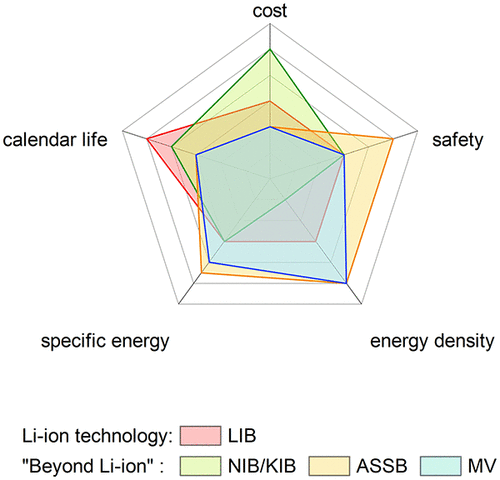当前位置:
X-MOL 学术
›
Chem. Rev.
›
论文详情
Our official English website, www.x-mol.net, welcomes your
feedback! (Note: you will need to create a separate account there.)
Promises and Challenges of Next-Generation “Beyond Li-ion” Batteries for Electric Vehicles and Grid Decarbonization
Chemical Reviews ( IF 51.4 ) Pub Date : 2020-12-24 , DOI: 10.1021/acs.chemrev.0c00767 Yaosen Tian 1, 2 , Guobo Zeng 1, 2 , Ann Rutt 2 , Tan Shi 2 , Haegyeom Kim 2 , Jingyang Wang 1, 2 , Julius Koettgen 2 , Yingzhi Sun 1, 2 , Bin Ouyang 1, 2 , Tina Chen 1, 2 , Zhengyan Lun 1, 2 , Ziqin Rong 2 , Kristin Persson 1, 2 , Gerbrand Ceder 1, 2
Chemical Reviews ( IF 51.4 ) Pub Date : 2020-12-24 , DOI: 10.1021/acs.chemrev.0c00767 Yaosen Tian 1, 2 , Guobo Zeng 1, 2 , Ann Rutt 2 , Tan Shi 2 , Haegyeom Kim 2 , Jingyang Wang 1, 2 , Julius Koettgen 2 , Yingzhi Sun 1, 2 , Bin Ouyang 1, 2 , Tina Chen 1, 2 , Zhengyan Lun 1, 2 , Ziqin Rong 2 , Kristin Persson 1, 2 , Gerbrand Ceder 1, 2
Affiliation

|
The tremendous improvement in performance and cost of lithium-ion batteries (LIBs) have made them the technology of choice for electrical energy storage. While established battery chemistries and cell architectures for Li-ion batteries achieve good power and energy density, LIBs are unlikely to meet all the performance, cost, and scaling targets required for energy storage, in particular, in large-scale applications such as electrified transportation and grids. The demand to further reduce cost and/or increase energy density, as well as the growing concern related to natural resource needs for Li-ion have accelerated the investigation of so-called “beyond Li-ion” technologies. In this review, we will discuss the recent achievements, challenges, and opportunities of four important “beyond Li-ion” technologies: Na-ion batteries, K-ion batteries, all-solid-state batteries, and multivalent batteries. The fundamental science behind the challenges, and potential solutions toward the goals of a low-cost and/or high-energy-density future, are discussed in detail for each technology. While it is unlikely that any given new technology will fully replace Li-ion in the near future, “beyond Li-ion” technologies should be thought of as opportunities for energy storage to grow into mid/large-scale applications.
中文翻译:

下一代电动汽车和电网脱碳的“超越锂离子”电池的前景和挑战
锂离子电池(LIB)在性能和成本上的巨大改进使它们成为电能存储的首选技术。尽管成熟的锂离子电池化学性质和电池体系结构可实现良好的功率和能量密度,但LIB不太可能满足储能所需的所有性能,成本和扩展目标,尤其是在电动运输等大规模应用中和网格。进一步降低成本和/或增加能量密度的需求,以及对锂离子自然资源需求的日益关注,加速了对所谓“超越锂离子”技术的研究。在这篇评论中,我们将讨论四种重要的“超越锂离子”技术的最新成就,挑战和机遇:钠离子电池,钾离子电池,全固态电池和多价电池。每种技术都详细讨论了挑战背后的基础科学以及实现低成本和/或高能量密度未来目标的潜在解决方案。尽管任何给定的新技术都不太可能在不久的将来完全取代锂离子电池,但是“锂离子电池以外”的技术应被视为储能向中大型应用发展的机会。
更新日期:2021-02-10
中文翻译:

下一代电动汽车和电网脱碳的“超越锂离子”电池的前景和挑战
锂离子电池(LIB)在性能和成本上的巨大改进使它们成为电能存储的首选技术。尽管成熟的锂离子电池化学性质和电池体系结构可实现良好的功率和能量密度,但LIB不太可能满足储能所需的所有性能,成本和扩展目标,尤其是在电动运输等大规模应用中和网格。进一步降低成本和/或增加能量密度的需求,以及对锂离子自然资源需求的日益关注,加速了对所谓“超越锂离子”技术的研究。在这篇评论中,我们将讨论四种重要的“超越锂离子”技术的最新成就,挑战和机遇:钠离子电池,钾离子电池,全固态电池和多价电池。每种技术都详细讨论了挑战背后的基础科学以及实现低成本和/或高能量密度未来目标的潜在解决方案。尽管任何给定的新技术都不太可能在不久的将来完全取代锂离子电池,但是“锂离子电池以外”的技术应被视为储能向中大型应用发展的机会。











































 京公网安备 11010802027423号
京公网安备 11010802027423号